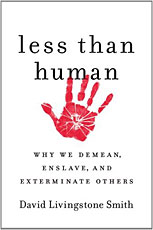"Harm is a thick concept. It's best understood as morally unacceptable damage. This definition implies that you can only harm a thing if it has some moral standing. There's an important connection here with pain and suffering, but not the connection that Goodall had in mind in her discussion of cruelty. Harm can be painless, and pain can be harmless, but the kinds of beings that can feel pain are the kinds of beings that can be harmed. Feeling pain is diagnostic of a creature's moral standing, but isn't constitutive of it.
"What kinds of beings have moral standing? What makes the difference between things that can suffer harm and things that can't? In some cases the answer is clear: People have moral standing and inanimate objects don't — people can be harmed, but inanimate objects can only be damaged. But where do all the other life-forms stand? Oddly enough, our judgments about this depend in large measure on where we position them on the great chain of being. This ancient, discredited, prescientific model of the cosmos still unconsciously serves as a guideline for our moral judgments. Recall that the great chain of being classifies things both in terms of their descriptive properties and in terms of their value; it's therefore thick from top to bottom. Inanimate objects are at the bottom of the chain, and have no value in themselves. Microorganisms and plants don't fare much better, which is why even the most zealous vegans can weed their garden and wipe out untold millions of germs with disinfectants ('green' ones, of course) without suffering a single pang of guilt. Intuitions get foggier as we climb higher. Is swatting a mosquito cruel? How about stepping on a cockroach or skewering a writhing worm on a fishhook? Plunging a living lobster into boiling water, or gutting a trout for dinner? Killing a chicken? Slaughtering a lamb? Performing an abortion? Executing a criminal?
"There's no fact of the matter about exactly where in this sequence damage gives way to harm, and destruction becomes cruelty, but the principle governing such judgments is both clear and embarrassingly narcissistic: the closer we judge a creature is to us on the hierarchy, the more inclined we are to grant it moral standing."
